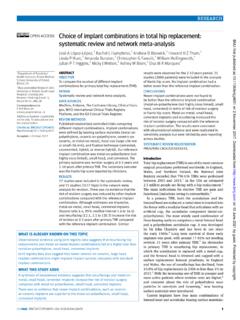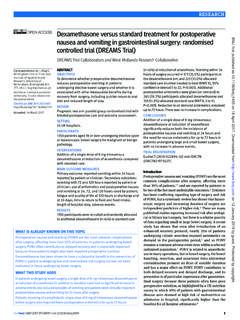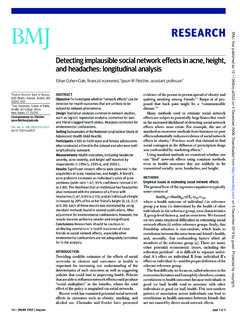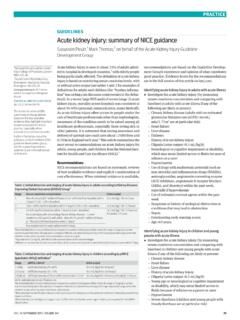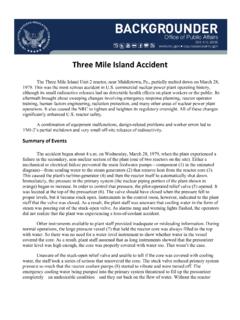Transcription of Central venous catheters - BMJ
1 28 BMJ | 16 NOVEMBER 2013 | VOLUME 347 CLINICAL REVIEW intravascular devices (such as pulmonary artery catheters and pacing wires). The catheter type is selected according to the indication for insertion and the predicted duration of use (see table 1).How are Central venous catheters inserted? Central venous catheters are inserted by practitioners from many different medical specialties and by allied medical practitioners. Someone who is trained and experienced in the technique should be responsible for the line insertion and it should be undertaken in an environment that facili-tates asepsis and adequate patient what anatomical site should I insert the Central venous catheter?The site of insertion depends on several factors: indica-tion for insertion, predicted duration of use, previous line insertion sites (where the veins may be thrombosed or stenosed), and presence of relative contraindications.
2 Ultrasound directed techniques for insertion are now the standard of care in the UK. The site of insertion and indica-tion for the catheter will influence infectious, mechanical, and thrombotic complication rates. A Cochrane systematic review of Central venous sites and complications concluded that, in patients with cancer and long term catheters , the risk of catheter related complications was similar for the internal jugular and subclavian For short term cen-tral venous catheters , this review concluded that the risk of catheter colonisation ( v ; relative risk , 95% confidence interval to ) and thrombotic com-plications ( v ; , to ) is higher for the femoral route than for the subclavian By contrast, a meta-analysis documented no difference in the risk of infectious complications between the internal jugular, subclavian, and femoral The ease of imag-ing of the internal jugular vein compared with the subcla-vian vein has made the first route more popular for short term access.
3 A Cochrane review found that for short term access, for haemodialysis, the femoral and internal jugular sites have similar risks of catheter related complications, although the internal jugular route is associated with a higher rate of mechanical Recent Kidney Disease Improving Global Outcomes (KDIGO) guidelines recommend, in order of preference, the right internal jugu-lar, femoral, left internal jugular, and subclavian veins for insertion of a short term dialysis venous catheterisation was first performed in 1929. Since then, Central venous access has become a mainstay of modern clinical practice. An estimated 200 000 Central venous catheters were inserted in the United Kingdom in 1994,1 and the figure is probably even higher today. Clini-cians from most medical disciplines will encounter patients with these catheters .
4 Despite the benefits of Central venous lines to patients and clinicians, more than 15% of patients will have a catheter related This review will provide an overview of Central venous catheters and inser-tion techniques, and it will consider the prevention and management of common are Central venous catheters ?A Central venous catheter is a catheter with a tip that lies within the proximal third of the superior vena cava, the right atrium, or the inferior vena cava. catheters can be inserted through a peripheral vein or a proximal Central vein, most commonly the internal jugular, subclavian, or femoral are the indications and contraindications to Central venous catheterisation?The indications for Central venous catheterisation include access for giving drugs, access for extracorporeal blood cir-cuits, and haemodynamic monitoring and interventions (box 1).
5 Insertion of a catheter solely to measure Central venous pressure is becoming less common. A systematic review found a poor correlation between Central venous pressure and intravascular volume; neither a single Central venous pressure value nor changes in this measurement pre-dicted fluid The need for fluid resuscitation can be evaluated using a test of fluid responsiveness, such as the haemodynamic response to passive leg of the contraindications to Central venous catheteri-sation (box 2) are relative and depend on the indication for types of Central venous catheter are available and how are they selected?Four types of Central venous catheter are available (table 1): non-tunnelled, tunnelled (fig 1A), peripherally inserted (fig 1C), and totally implantable (fig 2) catheters .
6 Specialist non-tunnelled catheters enable interventions such as intravascu-lar temperature control, continuous monitoring of venous blood oxygen saturation, and the introduction of other 1 North Bristol NHS Trust, Bristol, UK2 Royal United Hospital NHS Trust, Bath, UKCorrespondence to: J P Nolan this as: BMJ 2013;347:f6570doi: venous cathetersReston N Smith,1 Jerry P Nolan2 SUMMARY POINTSA wide variety of Central venous catheters are usedComplications related to Central venous catheters are common and may cause serious morbidity and mortalitySeveral strategies can reduce Central venous catheter related morbidity; these are implemented at catheter insertion and for the duration of its usePeripherally inserted Central catheters have the same, or even higher, rate of complications as other Central venous catheters Follow the link from the online version of this article to obtain certi ed continuing medical education creditsSOURCES AND SELECTION CRITERIAWe searched the Cochrane Database of Systematic Reviews, Medline, Embase, and Clinical Evidence online.
7 Search terms included Central venous catheter, peripherally inserted Central catheter, and complication. The reference lists of relevant studies were hand searched to identify other studies of interest. We also consulted relevant reports and national | 16 NOVEMBER 2013 | VOLUME 347 29 CLINICAL REVIEWBox 1 | Indications for Central venous catheterisationAccess for drugsInfusion of irritant drugs for example, chemotherapy Total parenteral nutritionPoor peripheral accessLong term administration of drugs, such as antibioticsAccess for extracorporeal blood circuitsRenal replacement therapyPlasma exchangeMonitoring or interventionsCentral venous pressureCentral venous blood oxygen saturationPulmonary artery pressureTemporary transvenous pacingTargeted temperature managementRepeated blood samplingBox 2 | Potential contraindications to Central venous catheterisationCoagulopathyThrombocytope niaIpsilateral haemothorax or pneumothoraxVessel thrombosis, stenosis, or disruptionInfection overlying insertion siteIpsilateral indwelling Central vascular devicesTechnique of inserting a cannula into the internal jugular veinBox 3 on describes in detail the technique for inserting a Central venous catheter (fig 3).
8 Skin preparationThe skin is prepared with a solution of 2% chlorhexidine in 70% isopropyl A meta-analysis found a reduc-tion in catheter related infections when chlorhexidine is used instead of However, a systematic review has highlighted that many of the studies on this topic have compared chlorhexidine in alcohol with aque-ous The immediate action of alcohol might combine with the more persistent effect of chlorhex-idine to produce optimal guidanceNational Institute for Health and Care Excellence (NICE) guidelines recommend using ultrasound guidance for the elective insertion of Central venous catheters into the inter-nal jugular vein in adults and A meta-analysis indicates that ultrasound guided placement results in lower failure rates, reduced complications, and faster access compared with the landmark Real time imaging of needle passage into the vessel can be performed out of plane ( vessel imaged in the transverse plane) or in-plane ( vessel imaged in the longitudinal plane).
9 An inter-national expert consensus group concluded that, although no one technique is better than another, a combination of the two may be The in-plane technique is tech-nically more challenging but enables the position of the tip of the thin walled needle (or cannula) and the wire to be identified precisely (for example, inadvertent penetra-tion of the posterior wall of the vein will be seen clearly). Although ultrasound imaging of the internal jugular and femoral veins is much easier than imaging of the subcla-vian vein (the view is obscured by the clavicle), ultrasound guided catheterisation of the subclavian vein is possible with the use of a slightly more lateral approach (initially entering the infraclavicular axillary vein).15 16 What is the optimal location for the tip of the Central venous catheter?
10 Incorrect placement of the catheter tip increases mechanical and thrombotic complications, but the ideal location of the catheter tip depends on the indications for catheterisation and the site of insertion. No single catheter tip position is ideal for all patients. Patients with cancer are at high risk for developing thrombosis. To reduce rates of thrombosis related to long term catheters in these patients, the catheter tip should lie at the junction of the superior vena cava and right atrium, which is below the pericardial reflection and lower than that recommended for other In other patients, expert opinion suggests that the tip should lie paral-lel to the wall of a large Central vein outside of the pericardial This reduces the risk of perforation and the risk of cardiac tamponade if perforation occurs.



